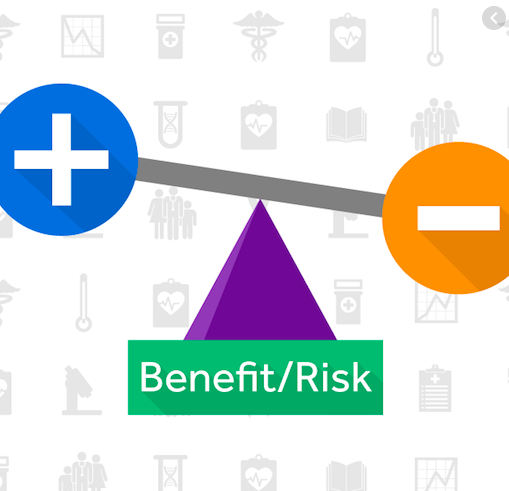Benefit-risk assessment is the continuous examination (at all phases preclinical, clinical and post marketing) of the favourable and unfavourable results of a specific treatment to determine whether its benefits outweigh its risks in a specific condition.
The benefit and risk profile of medicines have dual aspects. In some cases, new findings indicate the better safety profile or better therapeutic benefit of a drug but sometimes uncover side effects, making the safety profile of the drug less favourable.
Overview of risk benefit evaluation process:

- Signals of adverse reactions of medical importance arise typically from market experience, usually through spontaneous reports, but may surface also in large post- marketing or other studies, however, information from all sources must be used. (Read more about signal detection )
- Once the signal is detected the public-health perspective taken here requires the collection and analysis of data from many and varied sources.
- Once the data is available signal will be evaluated for risk. A signal may indicate a possible emergency (e.g., an imminent hazard to the population at risk), which calls for crisis management measures.
- If risk has major impact on patient then a benefit-risk assessment will be performed.
- Benefit-risk assessment is prompted by the appearance of a particular sign, symptom, symptom-complex or diagnosis, and one automatically tends to restrict the investigation to the particular signal. However, in weighing the benefits and risks of a drug against alternatives (or no treatment) in the light of a new, important risk, the impact of the new information must be reviewed in the total context of the drug’s use. Thus, it will usually be necessary to review its entire benefit-risk profile in the light of available treatment options.
- If there is change in benefit risk assessment then need to list all appropriate options for action. Describe the pros and cons and likely consequences (impact analysis) of each option under consideration, taking alternative therapies into account. If relevant, outline plans or suggestions for a study that could provide timely and important additional information. If feasible, indicate the quality and quantity of any future evidence which would signal the need for a re-evaluation of the benefit-risk relationship. Suggest how the consequences of the recommended action should be monitored and assessed.
- Decisions must be made on the basis of the available evidence, tempered by prior experience, political context and professional judgment. A central concept is ‘‘acceptable risk,’’ but the fundamental question is: ‘‘acceptable to whom.’’
- Decision must be communicate immediately to regulatory affairs (to generate prompt regulatory action as communication to applicable regulatory authorities and interested business partners) as an Emerging Safety Issue all validated signals pointing towards an implication for public health or the benefit-risk profile of the specific product.
- After an action other than complete withdrawal of a drug, data must continue to be collected as part of the ongoing monitoring of safety. Manufacturers and regulators have generally relied for this purpose on passive collection of data, mainly spontaneous reports. However, active surveillance or a survey may be a better way to generate data to test for the expected outcomes. The data should be periodically analysed to determine whether (1) the outcomes are those desired, (2) new information dictates further review and a possible modification of the original action, or (3) there are sufficient data to consider undertaking a new benefit-risk assessment.

